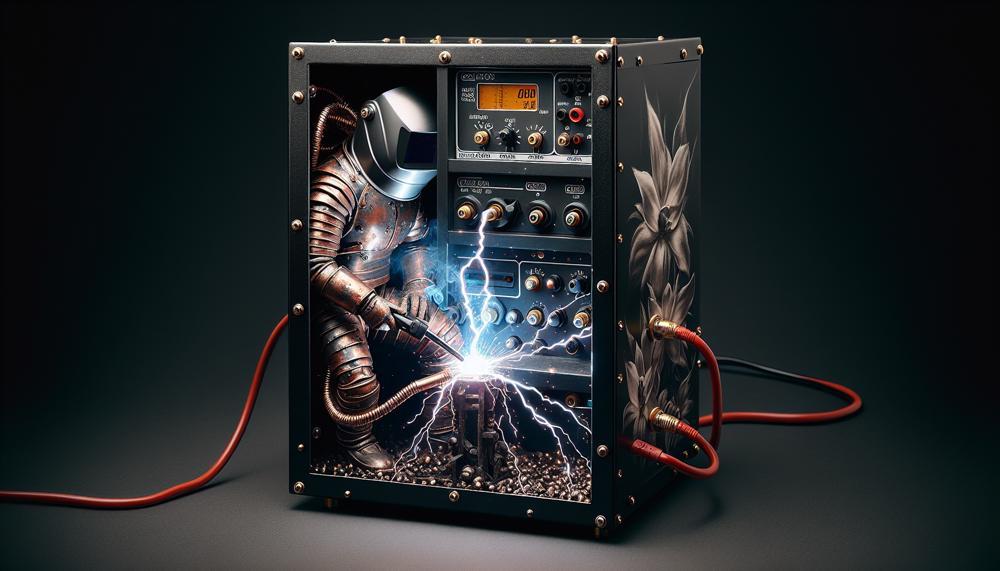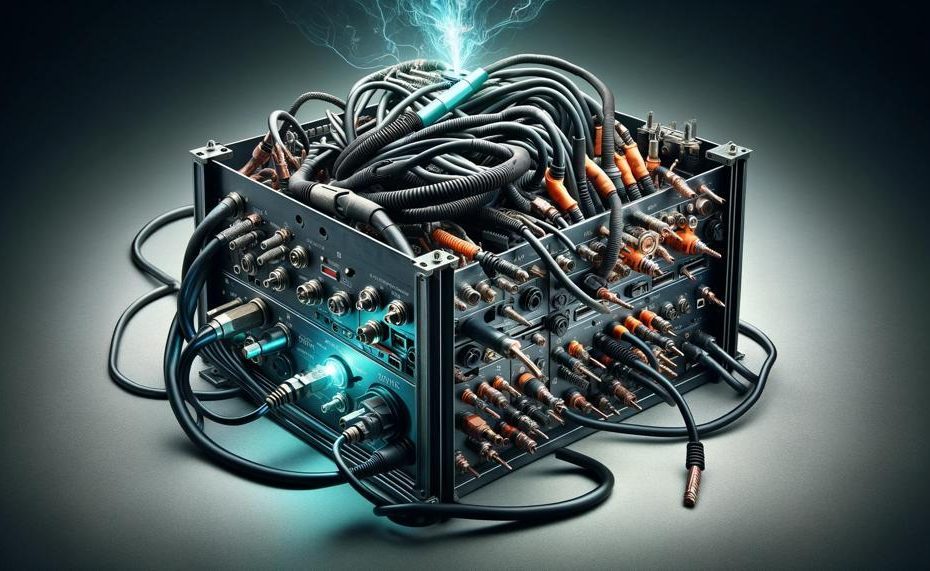Have you ever wondered whether MIG welding is best done with AC or DC power? If so, you’ve come to the right place. In this blog post, we’ll take a deep dive into this question and provide you with the necessary information to make an informed decision.
So, Is MIG Welding AC Or DC?
MIG welding is usually done with direct current (DC). DC means the current only flows in one direction. AC, or alternating current, means the current changes direction periodically.
MIG welders are almost always set to DC because it offers a stable arc, which ensures better weld penetration, bead quality, and less spatter. DC is often used in stick welding and TIG welding, especially when bonding stainless steel.
AC is usually a secondary choice for welding, but there are some instances where it’s preferred. For example, AC is better for welding magnetic materials.
Contents
What are AC and DC in Welding?
AC and DC are two different types of electrical currents commonly used in welding, including the popular MIG welding process. AC or alternating current has a unique characteristic of changing direction periodically, while DC or direct current flows in one constant direction. The main disparity between AC and DC in welding lies in their suitability for different materials and their impact on the welding process.
Typically, AC is preferred for welding non-ferrous metals and thicker materials as it delivers a higher heat output and better arc stability compared to DC. On the other hand, DC is more suitable for thinner materials as it offers precise control over the weld pool. Additionally, DC produces less spatter due to its stable arc, which results in less clean-up work.
Moving on to MIG welding, most machines use DC current, specifically DCEP (direct current electrode positive) polarity. This type of current interacts well with the machine and is ideal for welding thin metals. However, some machines come with the capability to switch between AC and DC, providing more versatility for welders who frequently work with a variety of materials.
Differences between AC and DC Current Flow in Welding Machine
When it comes to welding machines, there are two types of current flow that are commonly used: AC (alternating current) and DC (direct current). Both have their own unique advantages and differences, and understanding these differences is crucial for choosing the right type of welding machine for your needs.
One major difference between AC and DC current flow is the direction in which the electricity flows. In AC, the electricity changes direction periodically, while in DC, it flows in only one direction. This difference has a significant impact on the welding process.

AC current flow is typically used for welding materials that are relatively thin, such as aluminum. It offers a smoother and more stable arc, making it easier to control and resulting in cleaner welds. On the other hand, DC current flow is better suited for thicker materials and provides a more concentrated and powerful arc, making it ideal for welding heavy-duty materials such as steel.
Another key difference is the way in which AC and DC current flow interact with the welding rod. In AC, the current alternates between positive and negative, causing the welding rod to heat up and cool down repeatedly. This results in a burstier weld that can be more challenging to control. In contrast, DC current flow is more consistent and produces a smoother weld.
But which type of current flow is better? As with most things, it depends on your specific needs and preferences. Some welders prefer the burstier weld of AC, while others appreciate the consistency of DC. It’s best to try both types and see which one feels more comfortable for you.
Advantages and Disadvantages of AC in Mig
When it comes to welding, there are two main types of electric currents that are used – AC and DC, each with their own unique advantages and disadvantages. In MIG welding, AC is typically preferred for thicker materials, while DC is better suited for thinner materials. However, there are some noticeable differences between the two when it comes to MIG welding.
Using AC for MIG welding comes with several benefits, including its ability to weld thicker materials and its lower cost. This is because AC allows for a higher amperage output, making it more suitable for heavy-duty applications. Furthermore, AC machines tend to be more budget-friendly compared to DC machines.
However, there are also some drawbacks to using AC for MIG welding. One major disadvantage is the increased spatter compared to DC, which can result in a messier and less precise weld, requiring additional cleanup. Additionally, the deposition rate is slower with AC, meaning it will take longer to complete a weld using this type of current.
On the other hand, DC offers several distinct advantages for MIG welding. It provides a smoother welding output due to its constant polarity, resulting in a more stable arc and better control over the weld. It also offers deeper penetration, allowing for stronger and more durable welds. Moreover, DC has a quicker deposition rate compared to AC, making it more efficient for completing projects.
When using a MIG welder in DC mode, it is crucial to follow specific steps to set up the machine properly. This includes checking cable connections, setting electrode polarity, adjusting gas flow and tension, and replacing worn consumables.
Overall, while both AC and DC have their own advantages and disadvantages in MIG welding, many experts agree that DC is generally more suitable due to its overall performance. It offers better control, efficiency, and quality in the final weld. However, depending on your specific needs and the materials being welded, AC may still be a viable option.
Advantages and Disadvantages of DC in Mig
As with any welding method, there are both advantages and disadvantages to using direct current in MIG welding. However, the benefits of DC in MIG make it a highly preferred choice among professionals.
One of the main advantages of using DC in MIG welding is its stability and reliability. By providing a steady arc and consistent welding strength, DC ensures high-quality welds that meet industry standards.
In addition to this, DC also offers better control over the welding process. This results in more precise and accurate welds, making it a popular choice for projects that require a high level of precision.
One of the key strengths of DC is its versatility. It can be used for both vertical and overhead welds, making it suitable for a wide range of projects. This makes it a highly versatile option that can handle various welding applications with ease.
Another significant advantage of using DC in MIG welding is its strong welding strength. Due to its stability, DC produces stronger welds that are ideal for heavy-duty welding applications.
However, like any other welding method, there are also some drawbacks to using DC in MIG welding. One of the main disadvantages is its higher cost. Compared to AC machines, DC machines are often more expensive, making them a less budget-friendly option.
Furthermore, installing a DC machine may require additional electrical work as it needs a 220-volt breaker. This adds to the overall cost and may not be feasible for all projects.
Lastly, it’s important to note that DC is not suitable for welding magnetic materials. This may require additional effort to maintain consistency and can be a limitation for certain projects.
AC or DC, Which One Is Suitable for Mig Welding and Why?
When it comes to welding currents, there are two main types: alternating current (AC) and direct current (DC). These two types differ in the direction of the current flow, with AC alternating its direction and DC flowing in one direction.
While both have their own advantages and disadvantages, one is more suitable for MIG welding than the other.
AC Welding |
DC Welding |
| Although less preferred in MIG welding, AC welding can still be used for certain applications. It is commonly used for non-ferrous metals like aluminum and is more affordable than DC welding machines. | MIG welding machines typically use DCEP polarity, making DC welding the go-to choice due to its stability and control. This results in a stable arc and precise welds. |
| AC welding may be more affordable, but it is not as stable as DC welding and can produce excessive spatter, making it less ideal for precise welds. However, it can be suitable for thicker and magnetic metals. | On the other hand, DC welding offers better control over the weld, resulting in cleaner and stronger welds on thin metals. It also produces less spatter. |
| Compared to AC welding machines, DC welding machines are more expensive. They also have limitations when it comes to welding magnetic materials. | While AC welding machines are more affordable, they compromise on weld quality and arc stability. |
In conclusion, when it comes to MIG welding, DC welding is the preferred choice due to its stability, control, and ability to produce precise welds on thin metals. However, AC welding can still be used for certain applications and is a more affordable option.
How to Set Mig Welder in DC Mode?
Step 1: Get Familiar with Your Welder
- Take the time to learn about the various parts of your MIG welder, such as the power source, wire feeder, and gun.
- Make sure all components are in good condition and properly connected.
Step 2: Adjust the Polarity
- Change the polarity to direct current electrode negative (DCEN) or reverse polarity.
- This will ensure that the positive and negative terminals of your welder are correctly set for DC welding.
Step 3: Choose the Right Wire
- For welding steel and stainless steel, use ER70S-6 wire.
- When working with aluminum, opt for ER4043 or ER5356 wire.
Step 4: Determine the Appropriate Wire Feed Speed
- Consult your welder’s manual or seek advice from an expert to determine the ideal wire feed speed for your specific project.
- Factors like the material being welded, wire diameter, and welding position can all impact the wire feed speed.
Step 5: Set the Voltage
- When DC welding, set the voltage to a lower value.
- For steel and stainless steel, aim for a voltage between 15-20 volts.
- For aluminum, set it between 18-22 volts.
Step 6: Use the Right Gas
- A mixture of 75% argon and 25% carbon dioxide is ideal for welding steel and stainless steel.
- Pure argon gas should be used when working with aluminum.
Step 7: Test Your Welding Settings
- Before starting your project, test your settings on a scrap piece of metal.
- Make any necessary adjustments to ensure your welder is properly set up for DC welding.
Conclusion
In conclusion, the decision to use AC or DC power for MIG welding depends on a variety of factors, including material thickness and desired outcome. While AC is ideal for thinner materials, DC offers deeper penetration and better control over the weld. It’s important to carefully consider these factors before deciding which type of current is best for your project.
To fully understand the impact of AC and DC currents on welding, it’s crucial to have a solid understanding of both. By following the steps outlined in this article, you can confidently choose the most suitable option for your next MIG welding project.
Remember to keep key considerations in mind, such as material thickness, joint configuration, and electrode selection. It’s also important to be aware of where each type of current is commonly used – AC for home workshops and hobbyists, and DC for industrial settings.





